14
A conversation
Dr. Beth Harris and Dr. Steven Zucker
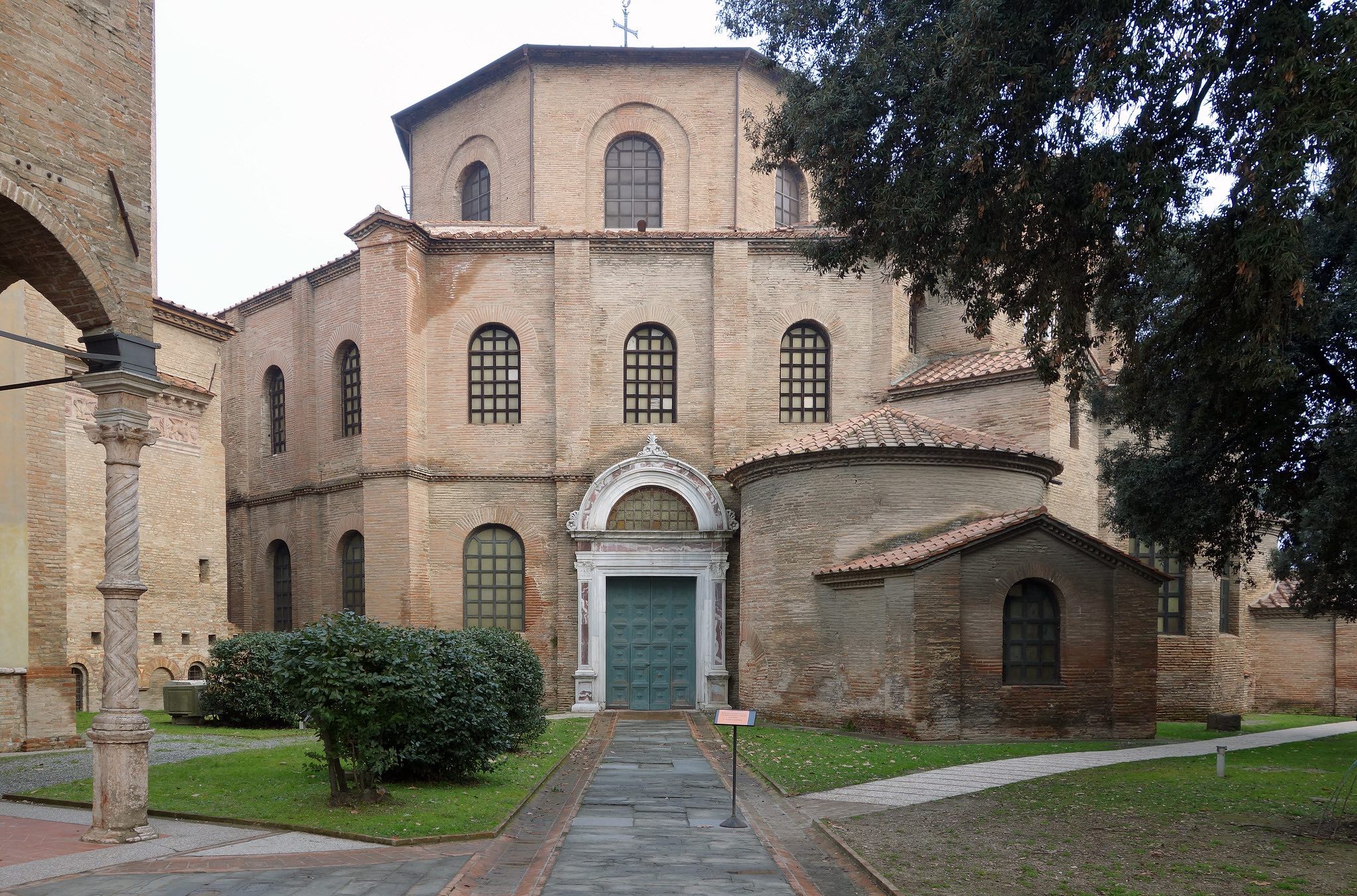
This is the transcript of a conversation conducted in the church of San Vitale in Ravenna, Italy.
Steven: We’re in the Italian city of Ravenna, standing outside of the Church of San Vitale. This is a really important 6th-century church. It’s just really old.
Beth: And it’s unusual in that it’s a centrally planned church — that means its focus is on its center instead of a basilica, which has a long, or longitudinal, axis.
Steven: Right. When we think about a church, we generally think about a building that’s shaped like a cross: it has that long hallway, the nave. This doesn’t have that. Instead, it’s got an ambulatory, or an aisle, that surrounds its central space. In this particular case, on the east side of the church, there’s also an extension with an apse at the end.
Beth: Looking at the outside of San Vitale, we see that it has eight sides, so it’s an octagon. And within that octagon is a smaller octagon that rises higher.
Steven: The exterior of the church is brick. Those bricks were taken from ancient Roman buildings and reused here in the 6th century. The walls are pierced with lots of windows. And that’s especially important because the interior is covered with some of the most magnificent mosaics that survive from the early medieval period.
Beth: Of course, you’d want that light glistening on the gold and beautifully colored mosaics! Let’s go inside and have a look.
Steven: We’ve walked into the church, and the center towers over us.
Beth: And yet, these apse-like shapes that are supported by columns undulate and move around us.
Steven: There are massive piers that help support the building. But there’s also a real delicacy. Look, for instance, at the way that the columns are doubled, that is, stacking one set of columns above the next.
Beth: And they move in and out back into the space of the ambulatory on the ground floor and then up into the gallery above.
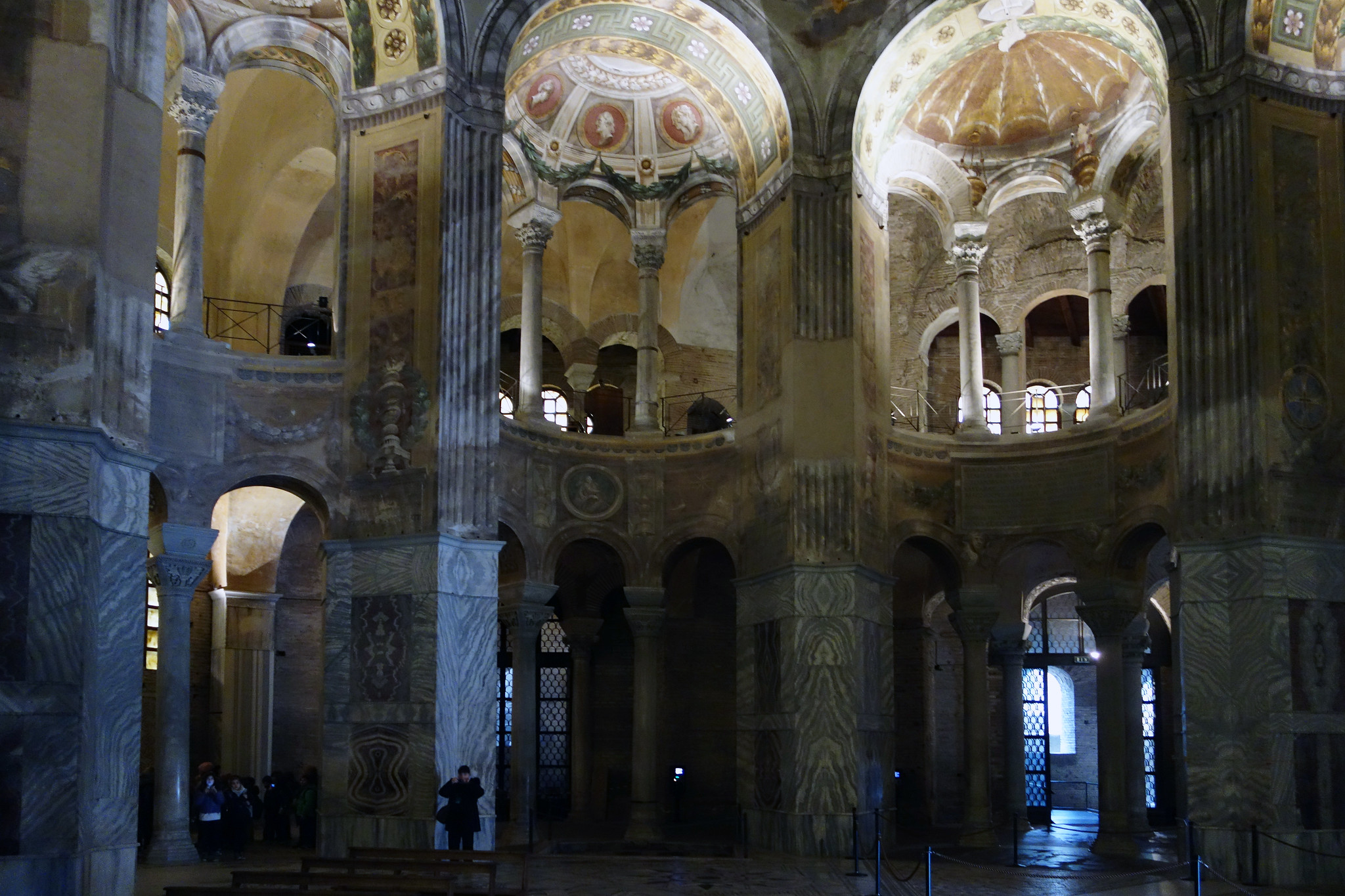
Steven: But the real gem in this church can be seen on the east end. Let’s walk over there. The eastern end of San Vitale is completely covered in dense mosaic.
Beth: These tiny pieces of glass and glass sandwiching gold that reflect the light.
Steven: We’re walking up towards the apse now, the semicircular space. There are three large windows, and just about that, a large apse mosaic.
Beth: In the center, we see Christ dressed royally in purple sitting on an orb, the orb of the Earth, of the universe. Below flow the four rivers of paradise. And on either side of him, an angel.
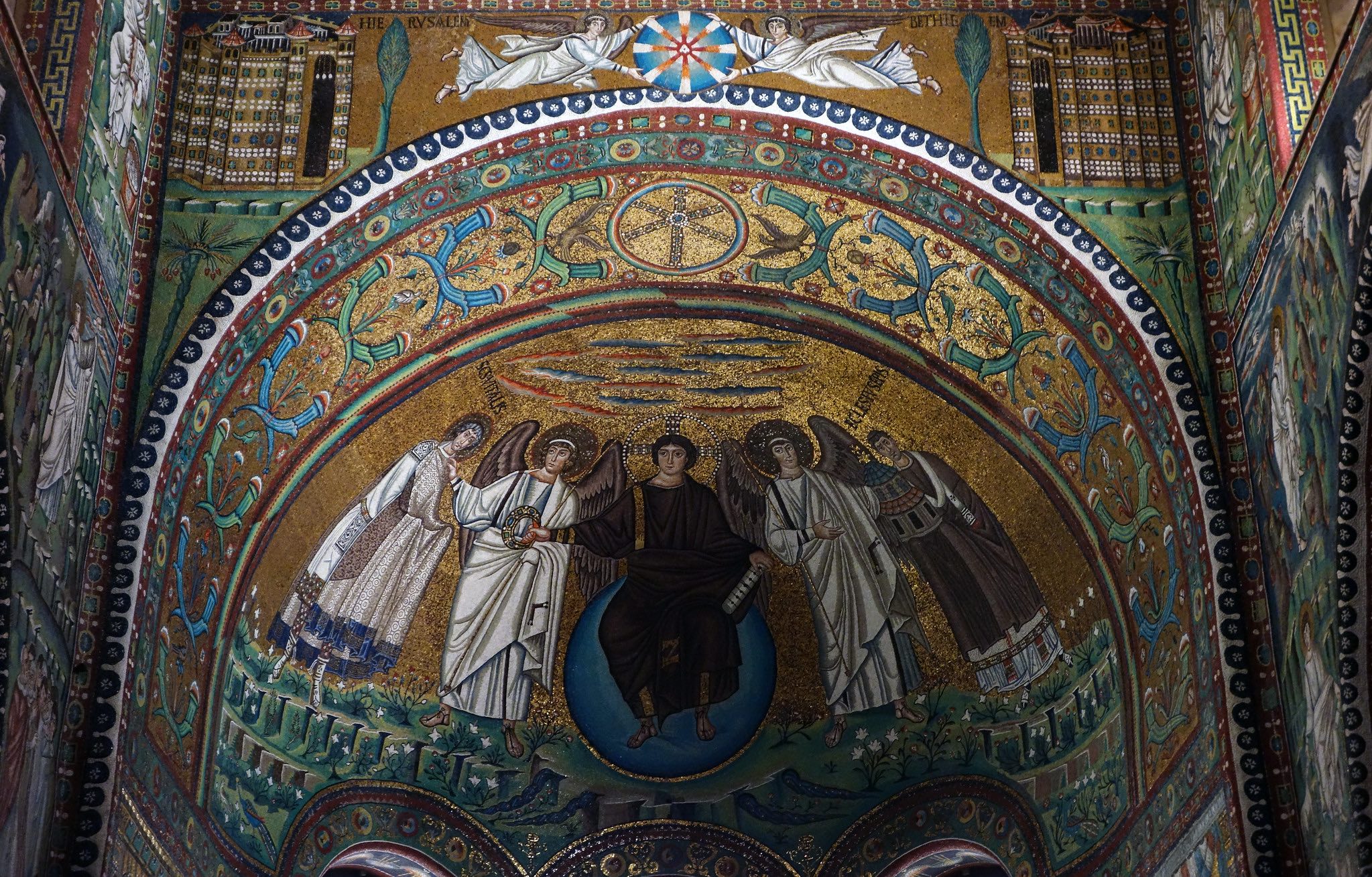
Steven: Christ is holding the book of the apocalypse with the seven seals visible. And in his right hand, he’s handing a crown to St. Vitalis, who was adopted as the primary martyr of this city.
Beth: And on the other side, we see Ecclesius, who founded and sponsored the building of this church. We see him handing the church to the angel beside Christ. Every surface here in the apse is covered with imagery, with figures, with decorative patterning.
Steven: The only surfaces that really are stone are of a very decorative marble, cut to pair and create wonderful abstract designs. It is this lush, glorious space here in this city that’s distant, perhaps, from the capital of the empire, but that speaks to its importance.
Beth: Right above the altar, we see an image of the Lamb of God. And the Lamb of God refers to Christ. He’s wearing a halo — this idea of Christ as the sacrificial lamb, sacrificed for the redemption of mankind.
Steven: The lamb is surrounded by a wreath of victory: in this case, the idea of the triumph of Christianity itself. That wreath is held in place by four angels who stand on globes that refer to the globe upon which Christ in the apse sits.
Beth: And then we see Christ again — but this time bearded, older — in the archway at the beginning of the chancel.
Steven: Right. The triumphal arch has Christ in the center. It’s really a kind of bust-length portrait. And his body is surrounded by a mandorla, a kind of rainbow-colored halo. Then, moving down the arch on either side are 14 figures, including the apostles.
Beth: We see scenes from the Old Testament, specifically ones that pre-figure the life of Christ and Christ’s sacrifice, and we see scenes from the New Testament.
Steven: There are also fabulously decorative columns made out of a high-quality marble that was brought from the east. What’s most remarkable about these columns for me is that we’ve really left behind the Classical orders. These are not Doric, they are not Ionic, they are not Corinthian. They are early Christians trying to invent a new iconography for their architecture.
Beth: And on top of the capitals, we see something called impost blocks that help make the transition up to the arches.
Steven: The two most important mosaics in San Vitale flank the apse.
Beth: And those show the Emperor Justinian and his empress, Theodora. Now, Justinian and Theodora never actually came to Ravenna.
Steven: And they’re in the mosaics, we think, to reassert their control over the city.
Beth: For much of the 400s, Ravenna was under the control of a Goth, Theodoric (ruled Italy 493-526), and Theodoric was an Arian, that is, he didn’t follow the orthodoxy, the Orthodox doctrines of the church.
Steven: Basically, the Arians believed that Christ was the creation of God the Father and therefore was subordinate in the hierarchy of the Trinity.
Beth: Christ was a co-equal with God the Father the way he is in Orthodox Christian belief. And so Justinian, the emperor in Constantinople in the early 500s, sends his general, Belisarius, to conquer Italy, to reconquer Ravenna, and reestablish Orthodox Christian belief here in Ravenna.
Steven: And the Arian belief was suppressed. And so what we’re seeing here is the reassertion of Eastern imperial control. That is, Justinian is in Constantinople in the east, and he is saying, “I’m in charge even here in Ravenna, in Italy.”
Beth: Spiritual power go hand in hand with political power, with the power of the emperor.
Steven: We see Justinian in the center wearing purple, the color that is associated with the throne. And he’s surrounded by his court. But there are also religious figures representing the church, and there are soldiers, three centers of power: the church, the emperor, and the military.
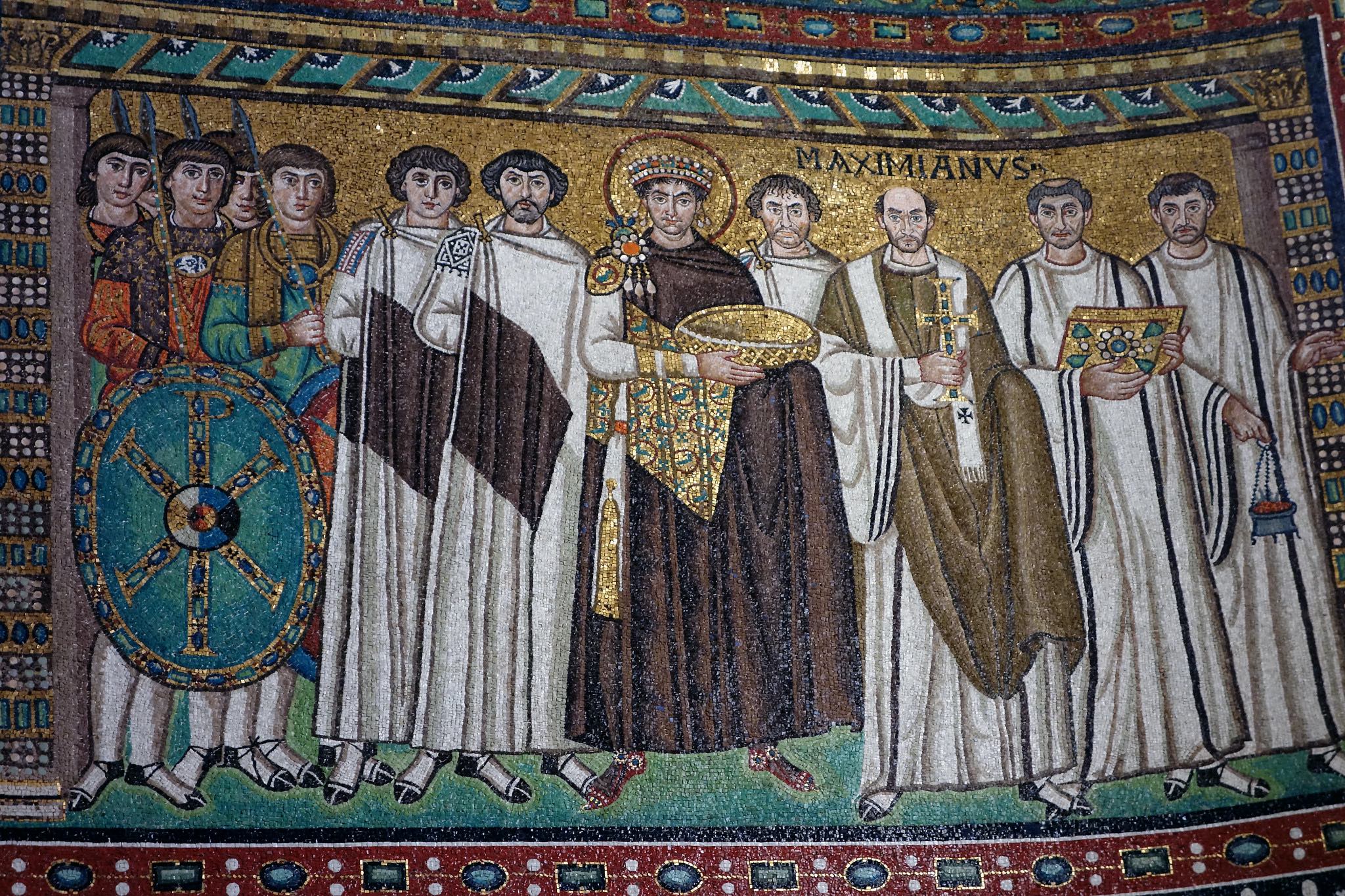
Beth: We can see that some of the figures are treated more individualistically than others. Justinian, Maximian are more individualized… It’s possible that people at the time would have looked up and recognized the other figures who are lost to us today. But the figures from the army are much more anonymous.
Steven: Justinian, the emperor authority, is divine; you can see a halo around his head. He holds a bowl associated with the Eucharist, which he is handing in the direction of Christ in the apse.
Beth: Right, this is a bowl that would have contained the bread for the sacrament of the Eucharist. He’s in the center of the composition. He’s frontal. But really all of the figures in this mosaic are frontal.
Steven: They are schematic, abstracted. This is the medieval period. We’ve left the Classical tradition of naturalism behind.
Beth: And so if we look closely at the figures, we can see that there’s no real concern for accurate proportions. Their feet don’t really seem to carry the weight of their bodies. They seem to float in an eternal space and not in an earthly space. Next to Justinian, we see the bishop, Maximian, with his name above him, although that was added later. And beside him, other clergymen.
Steven: Maximian holds a beautiful jeweled cross.
Beth: The figures next to him hold a jeweled book of the Gospels. And the figure at the far right holds an incense burner. What we’re seeing here is the emperor leading a procession for the enactment of the sacrament of the Eucharist.
Steven: In fact, the Eucharist would have been performed in the sanctuary. The figures stand in front of a field of gold, which is very much a Byzantine tradition.
Beth: When we say Byzantine, we’re referring to the capital of the empire, which is a Constantinople.
Steven: Which we now call Istanbul. You’ll notice that the tesserae — that is, these small pieces of colored glass, many of them with gold leaf that is actually fused almost like a sandwich in between two pieces of clear glass — are set into the wall at angles so that the light reflects off them in a way that is complicated and beautiful and creates a sense of the liveliness of the surface. And that would have been especially true when it was illuminated by candles and by lanterns. Let’s walk around to the other side and take a look at the panel devoted to Theodora, Justinian’s wife. To the right of the apse windows, we see the panel of Theodora, the empress, and it mirrors the panel with Justinian.
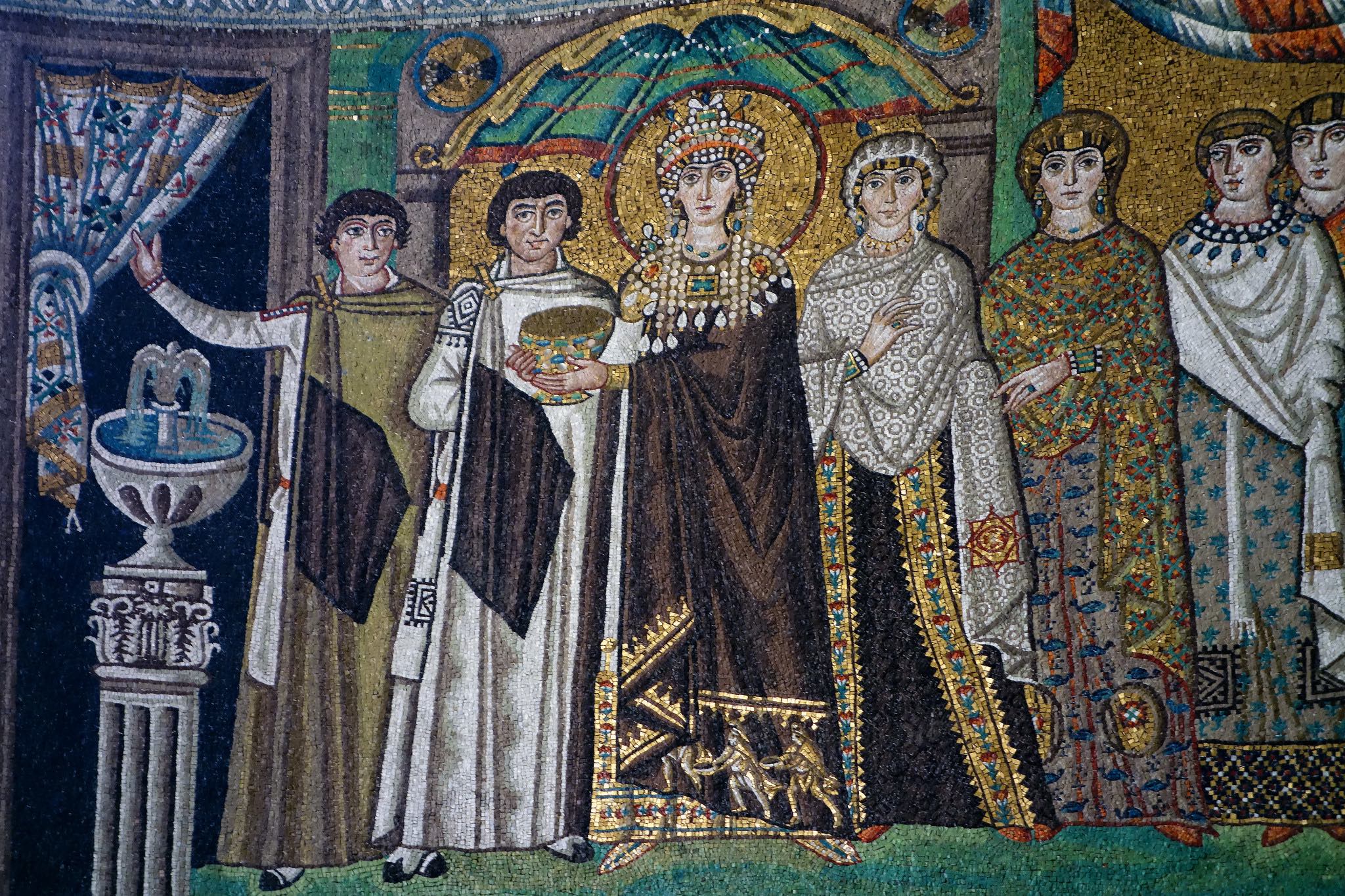
Beth: So we have an idea that Theodora, Justinian’s empress, ruled as co-equal to Justinian, that she was a very powerful woman, even though she was reputedly of the lower class — that she was an entertainer, apparently.
Steven: There are some colorful descriptions of her past. She’s wearing incredibly elaborate clothing and jewelry with rubies, with emeralds, with sapphires, and very large pearls. And in back of her head, just like Justinian, is a halo, which speaks not to her own divinity, but to the divine origin of her authority.
Beth: Like Justinian, who’s carrying a bowl that held the bread for the Eucharist, Theodora is carrying the chalice for the wine for the Eucharist. And like Justinian, too, she’s surrounded by attendants that symbolize the imperial court. A curtain is raised as though she is about to take part in a ceremony related to the Eucharist.
Steven: I’m really taken by the elaborate Byzantine costume.
Beth: Well, there’s a sense of trying to bring the richness of the imperial court in Constantinople here to Ravenna.
Watch the video <https://youtu.be/It3i-dKusIM>.
